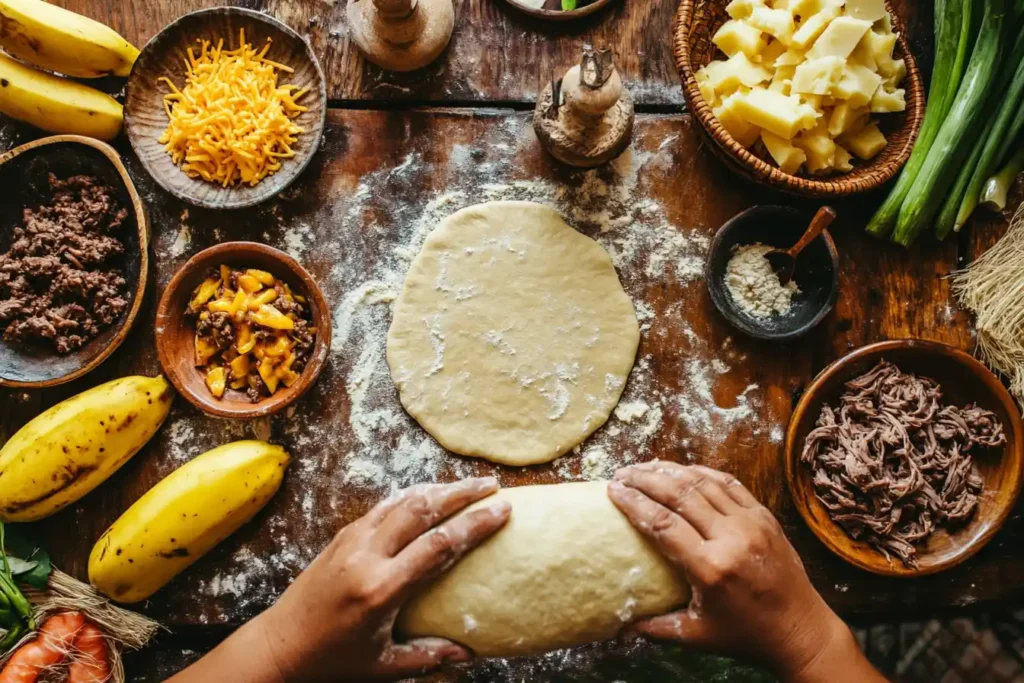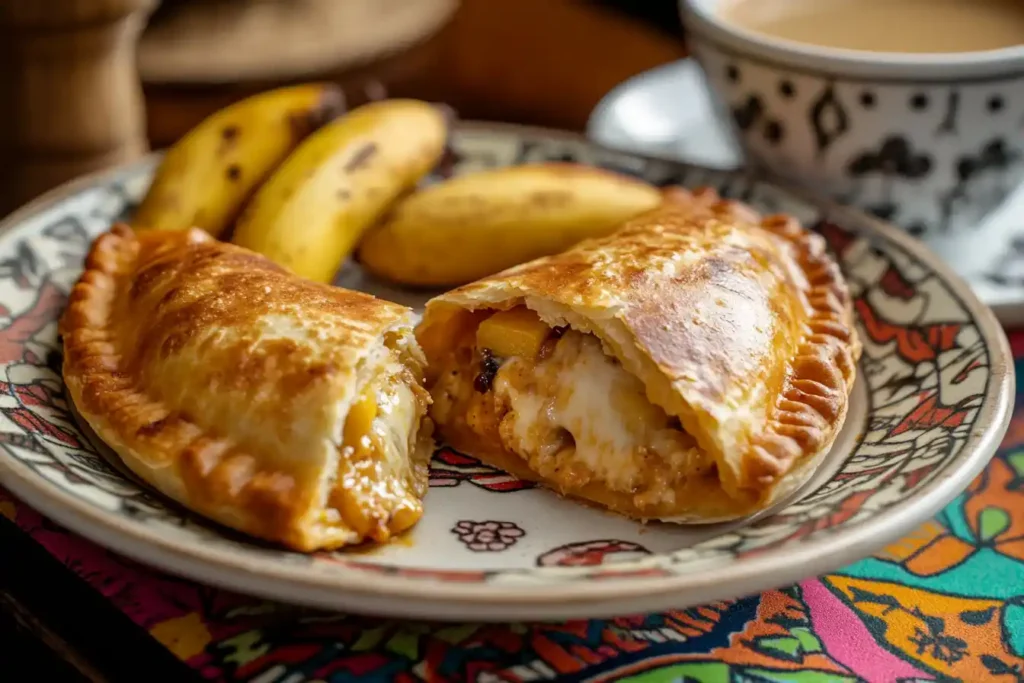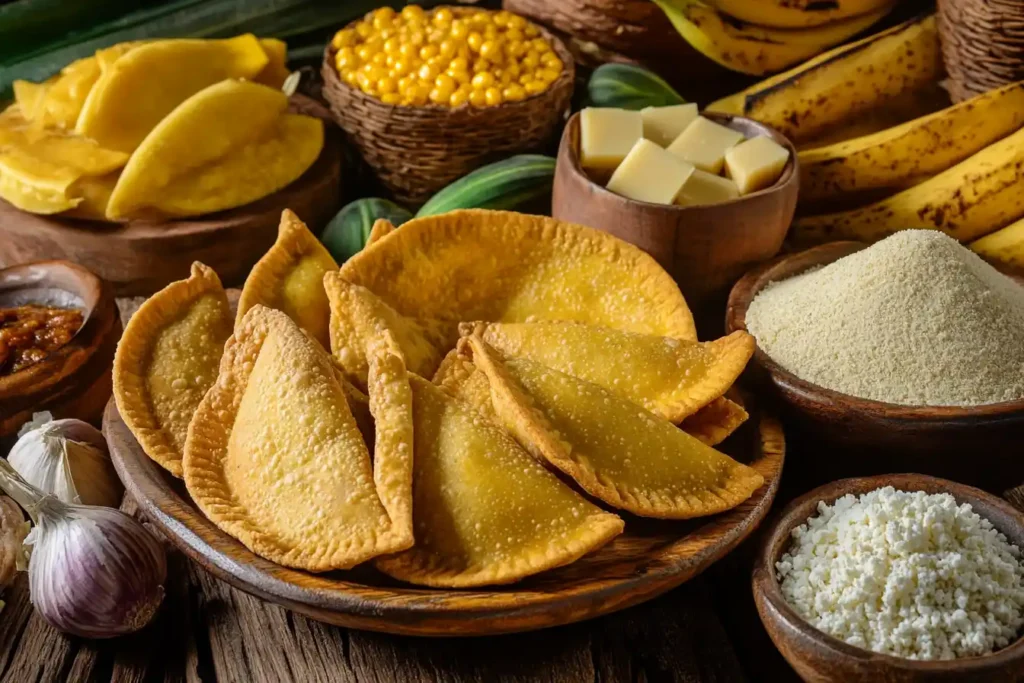Venezuelan cuisine is a treasure trove of flavors, and few dishes capture its essence quite like Empanadas Venezolanas. These crispy, golden pockets filled with an array of sweet or savory delights are a staple in Venezuelan households and streets alike. From their rich history to modern-day variations, this article dives deep into everything you need to know about these delectable turnovers. Whether you’re a foodie looking to explore Latin American dishes or someone eager to recreate a piece of Venezuela in your kitchen, this guide has it all. Let’s get started!
Introduction to Empanadas Venezolanas
What Are Empanadas Venezolanas?
Empanadas Venezolanas are a quintessential part of Venezuelan gastronomy. Unlike their counterparts from other countries, these empanadas are made with a unique cornmeal dough, giving them a distinct texture and flavor. Shaped like half-moons, they are often fried to crispy perfection, though baked versions have gained popularity for health-conscious eaters. Fillings range from shredded beef, cheese, and chicken to more exotic options like black beans and plantains.
What sets these empanadas apart is their versatility. They can be enjoyed as a hearty breakfast, a mid-day snack, or even a complete meal. Many Venezuelans hold fond memories of devouring these handheld delights from street vendors or making them with family during festive occasions.
The Cultural Significance of Empanadas Venezolanas in Venezuela
Empanadas are more than just food in Venezuela—they’re a symbol of community and tradition. Families gather to prepare them, often spending hours perfecting the dough and experimenting with fillings. Whether served during holidays, birthdays, or casual gatherings, Empanadas Venezolanas hold a special place in the hearts of Venezuelans.
Beyond the home, these fried turnovers dominate the country’s vibrant street food scene. Vendors, known for their colorful carts and friendly banter, lure passersby with the irresistible aroma of freshly fried empanadas. They’re not just a meal but an experience that reflects Venezuela’s warm and welcoming culture.
Common Ingredients for Making Authentic Empanadas Venezolanas
To make authentic Empanadas Venezolanas, you’ll need a handful of simple yet specific ingredients:
- Cornmeal: Precooked corn flour (harina PAN) is a must.
- Fillings: Cheese, shredded beef, chicken, plantains, or beans.
- Seasonings: Garlic, cumin, and fresh herbs enhance the flavor.
- Oil: For frying, usually vegetable or sunflower oil.
The secret lies in the dough’s consistency—smooth and pliable yet firm enough to hold the stuffing without breaking during frying. And let’s not forget the fillings! Venezuelans love experimenting, creating a medley of tastes to suit every palate.
Historical Background of Empanadas Venezolanas
The Origins of Latin American Empanadas and Their Venezuelan Twist
The story of empanadas begins centuries ago, tracing its roots to the Moorish influence on Spanish cuisine. As the Spanish settlers traveled to Latin America, they introduced their version of empanadas, a dish influenced by the Arabian sambousek. However, in Venezuela, the empanada evolved into something uniquely its own, using cornmeal dough instead of wheat flour.
In time, Empanadas Venezolanas became a reflection of the country’s rich biodiversity and agricultural resources. The use of precooked corn flour, locally known as harina PAN, is a testament to the reliance on corn, a staple crop in the region.
How Venezuelan Empanadas Differ From Other Variants
While empanadas exist across Latin America, Venezuela’s take on these turnovers is truly distinctive. The use of precooked cornmeal creates a gluten-free dough that is both crispy and tender when fried. The fillings are another highlight—whether it’s the traditional shredded beef or the creative addition of seafood like shark (cazón), Empanadas Venezolanas showcase the nation’s culinary ingenuity.
Unlike baked empanadas in Argentina or the flaky crust of Spanish empanadas, the Venezuelan version is known for its golden, deep-fried exterior. This method not only adds crunch but also enhances the rich, savory flavors of the fillings.
Evolution of Recipes Over Time
Through the years, Empanadas Venezolanas have adapted to modern tastes and dietary preferences. Traditional fillings like cheese, black beans, and plantains remain favorites, but innovative versions featuring vegan ingredients or fusion flavors have emerged. This evolution speaks to the dish’s versatility and timeless appeal.
For a deeper dive into Latin American culinary history, you might explore this detailed post about Reina Pepiada, another Venezuelan classic that highlights corn-based dishes.
The Making of Empanadas Venezolanas
Step-by-Step Guide to Preparing the Dough

Making the perfect dough is the foundation of Empanadas Venezolanas. Start by mixing harina PAN with water, a pinch of salt, and a splash of oil. The goal is to achieve a dough that is firm yet pliable—soft enough to fold but sturdy enough to hold the filling during frying.
Once mixed, knead the dough for a few minutes, then let it rest. This step allows the ingredients to blend, creating a smooth, cohesive texture. Divide the dough into small balls, flatten each into a disc, and you’re ready to add the filling!
Traditional Fillings and Their Preparation
The beauty of Empanadas Venezolanas lies in their diverse fillings. Popular options include:
- Shredded Beef: Slow-cooked beef, seasoned with garlic, onions, and cumin, makes a hearty filling.
- Cheese: A simple yet satisfying choice, often using local white cheeses like queso duro or queso de mano.
- Cazón (Shark): A coastal specialty featuring spiced shredded shark meat.
- Sweet Plantains and Black Beans: A vegetarian favorite that balances savory and sweet flavors.
For each filling, it’s essential to season well. Venezuelan cuisine relies heavily on bold, aromatic spices, so don’t skimp on garlic, cumin, or fresh herbs.
Cooking Techniques: Frying, Baking, and Beyond
Frying is the traditional way to cook Empanadas Venezolanas. Heat vegetable oil in a deep pan, ensuring it’s hot enough to create a crispy crust without burning. Gently place the empanadas in the oil, frying until golden brown on both sides. Drain excess oil on paper towels before serving.
For a healthier twist, baked empanadas are becoming increasingly popular. Brush them with oil or egg wash before placing them in the oven to ensure a golden finish.
Popular Variations of Venezuelan Empanadas
Regional Specialties in Venezuela
Across Venezuela, the filling of Empanadas Venezolanas often reflects the region’s culinary traditions and available ingredients. For instance, coastal areas are known for their seafood-inspired fillings like cazón (shark), which is both flavorful and unique to the area. Meanwhile, in the Andes, you might find empanadas filled with hearty stews, potatoes, or locally sourced cheeses.
In the central plains, shredded beef with plantains—a delightful mix of sweet and savory—is a common favorite. In addition, no matter where you go, the creativity and variety of regional empanadas therefore highlight the richness of Venezuelan culture.
Sweet vs. Savory Fillings: Options and Preferences
One of the most exciting aspects of Empanadas Venezolanas is the balance between sweet and savory options. Savory fillings like shredded chicken, black beans, or ham and cheese dominate breakfast and snack menus. However, sweet empanadas, filled with guava paste or caramelized plantains, are a delightful dessert or midday treat.
The ability to switch between flavors makes these turnovers perfect for any time of the day. Whether you prefer the traditional meat-filled versions or a modern sweet twist, there’s always an empanada to satisfy your craving.
Vegan and Modern Adaptations of Empanadas Venezolanas
Vegan and gluten-free diets have sparked creative adaptations of Empanadas Venezolanas. For example, fillings like spiced lentils, sautéed mushrooms, or seasoned jackfruit mimic the textures and flavors of traditional fillings, providing a plant-based alternative that retains the dish’s essence.
Moreover, for the dough, cassava flour or other gluten-free substitutes can be used, catering to those with dietary restrictions. Thus, these modern takes ensure empanadas remain inclusive and appealing to a broader audience.
Empanadas Venezolanas in the Modern World
Empanadas in Venezuelan Street Food Culture
A cornerstone of Venezuela’s vibrant street food culture is the beloved dish known as Empanadas Venezolanas. For instance, walk through any bustling city or rural town, and you’ll find vendors serving freshly fried empanadas to eager customers. They are often accompanied by guasacaca, a zesty avocado-based sauce that enhances their flavor.
In addition, street vendors have a knack for creating innovative fillings, turning each empanada into a unique culinary experience. However, it’s not just about the food—it’s also about the connection between vendor and customer, making every bite a taste of Venezuela’s vibrant spirit.
Global Popularity and Fusion Variants
In recent years, Empanadas Venezolanas have gained popularity far beyond Venezuela’s borders. For example, restaurants and food trucks in the U.S., Europe, and Asia are embracing these turnovers. Moreover, they are often blending traditional fillings with local ingredients to create fusion versions, showcasing their adaptability and universal appeal.
For example, empanadas stuffed with pulled pork and barbecue sauce are becoming a hit in North America, while seafood-inspired fillings are favored in coastal European cities. This global reach is a testament to the adaptability and universal appeal of Venezuelan empanadas.
How Social Media Promotes Venezuelan Cuisine
Social media platforms like Instagram and TikTok have played a huge role in spreading the love for Empanadas Venezolanas. From recipe videos showcasing step-by-step preparation to food bloggers raving about their first taste, these platforms help introduce the dish to a global audience.
Home cooks and professional chefs alike share their creations, inspiring others to try making empanadas at home. This digital exposure has turned Empanadas Venezolanas into an international sensation, encouraging people worldwide to explore Venezuelan flavors.
Frequently Asked Questions
What Is the Difference Between Colombian and Venezuelan Empanadas?
While both Colombian and Venezuelan empanadas share the concept of stuffed dough pockets, the two are quite distinct. Venezuelan empanadas are made with precooked cornmeal dough, giving them a soft yet crispy texture when fried. Colombian empanadas, on the other hand, often use a finer cornmeal dough, resulting in a more delicate crunch.
Fillings also differ. Empanadas Venezolanas are known for their variety, including shredded beef, chicken, black beans, and cheese. Colombian empanadas traditionally feature spiced ground meat and potatoes, offering a hearty and savory bite.
What Types of Empanadas Exist in Venezuela?
Venezuela boasts a vast array of empanadas, reflecting the country’s diverse regions and flavors. Popular types include:
- Shredded Beef Empanadas: A classic, savory option enjoyed nationwide.
- Cheese Empanadas: Perfect for breakfast or as a quick snack.
- Cazón (Shark) Empanadas: A coastal favorite with a unique seafood twist.
- Sweet Plantain Empanadas: A delightful mix of sweetness and texture.
Each region adds its own spin, from using local spices to pairing empanadas with unique sauces like ají dulce or guasacaca.
How Do Spanish and Mexican Empanadas Compare?
Spanish empanadas are typically large and baked, often resembling a pie. They use wheat-based dough and are filled with ingredients like tuna, vegetables, or pork. Mexican empanadas, meanwhile, can be either sweet or savory, with fillings such as pumpkin, apples, or meat.
Venezuelan empanadas stand out with their cornmeal dough and fried preparation. The crispy exterior and bold flavors of Empanadas Venezolanas make them a unique delight.
Are Argentine Empanadas Similar to Venezuelan Ones?
Argentine empanadas differ significantly from their Venezuelan counterparts. They use wheat flour dough, are usually baked, and feature a variety of fillings, including minced meat, boiled eggs, and olives. Venezuelan empanadas, with their fried cornmeal shells and diverse fillings, provide a completely different texture and flavor experience.
Health and Nutritional Information
Are Empanadas Venezolanas Healthy?
Like any fried food, Empanadas Venezolanas should be enjoyed in moderation. Their calorie content depends on the filling and cooking method. While frying gives them their iconic crunch, it also increases their fat content. That said, the use of cornmeal dough makes them gluten-free, offering a suitable option for those with dietary restrictions.
If filled with nutrient-rich ingredients like black beans, lean proteins, or vegetables, empanadas can be a balanced meal. Pairing them with a fresh salad or fruit can further enhance their nutritional value.
Tips for Making Healthier Empanadas
For a lighter version of Empanadas Venezolanas, consider baking instead of frying. Brushing the empanadas with a thin layer of oil or egg wash before baking ensures a golden, crispy finish with less fat. Additionally, opt for wholesome fillings like grilled vegetables, spiced lentils, or lean shredded chicken to reduce calorie content.
Another tip is to control portion sizes—smaller empanadas can help satisfy cravings without overindulging. Incorporating fresh herbs and spices boosts flavor without adding extra calories or sodium.
Recipes for Empanadas Venezolanas You Must Try
Classic Cheese-Filled Empanadas

Cheese-filled Empanadas Venezolanas are a staple and beloved by many for their simplicity and flavor. To make them:
- Prepare the dough using precooked cornmeal and water until smooth.
- Fill each disc with your favorite Venezuelan cheese, such as queso de mano or mozzarella for a stretchy, gooey texture.
- Fold the dough over the filling, sealing the edges tightly.
- Fry in hot oil until golden and crispy, ensuring the cheese melts perfectly inside.
Serve with guasacaca or a tangy hot sauce for an extra flavor kick. These cheese empanadas are perfect for breakfast or as a snack.
Shredded Beef and Plantain Empanadas
For a hearty option, try shredded beef and plantain empanadas. The sweetness of the plantains complements the savory beef filling beautifully. Here’s how:
- Cook shredded beef with garlic, onions, cumin, and a splash of tomato sauce for depth.
- Slice ripe plantains and fry until caramelized.
- Add both to the empanada dough, ensuring even distribution for every bite.
- Fry or bake until crispy.
This combination is a quintessential Venezuelan flavor experience, blending savory and sweet harmoniously.
Sweet Empanadas: Guava and Cheese
Sweet empanadas are a delightful twist, often enjoyed as desserts. The combination of guava paste and cheese creates a perfect balance of tangy and sweet. To make them:
- Slice guava paste and layer it with cream cheese or Venezuelan white cheese.
- Place the mixture inside the dough and seal well to prevent leaking.
- Fry until golden, or bake for a lighter option.
These sweet Empanadas Venezolanas are a crowd-pleaser and pair wonderfully with a cup of coffee or hot chocolate.
Tips and Tricks for Perfect Empanadas
Avoiding Common Dough Mistakes
The dough is the foundation of any great Empanadas Venezolanas. To avoid common pitfalls:
- Use the right type of cornmeal, specifically harina PAN, for an authentic texture.
- Add water gradually to achieve a dough that’s pliable but not sticky.
- Rest the dough for a few minutes before shaping to improve elasticity and prevent cracking.
Properly preparing the dough ensures a seamless cooking process and perfectly shaped empanadas every time.
Secrets to Achieving Perfect Crispy Empanadas
For the crispiest results, always fry Empanadas Venezolanas in hot oil. Use enough oil to submerge the empanadas, and avoid overcrowding the pan, which can lower the oil temperature. To test readiness, drop a small piece of dough into the oil—it should sizzle immediately.
If you prefer baking, brush the empanadas with oil or egg wash to achieve a golden exterior. Additionally, preheating the oven ensures even cooking.
With these tips, your empanadas will be golden, crispy, and irresistible, whether fried or baked.
Conclusion and Final Thoughts
Why Empanadas Venezolanas Are a Must-Try Dish
Empanadas Venezolanas are more than just a delicious meal; they are a reflection of Venezuelan culture and culinary creativity. With their golden, crispy exterior and endless filling possibilities, these turnovers are perfect for every occasion—from a casual breakfast to a festive celebration. Their versatility, rooted in tradition, has helped them capture the hearts (and stomachs) of food lovers around the world.
Whether you prefer savory classics like shredded beef and plantains or indulge in sweet variations like guava and cheese, Empanadas Venezolanas offer something for everyone. They are not just a dish—they’re an experience that connects you to the warmth and vibrancy of Venezuela.
Incorporating Venezuelan Empanadas Into Your Meals
Bringing Empanadas Venezolanas into your kitchen is easier than you might think. With a little practice and the right ingredients, you can recreate this beloved dish and savor its authentic flavors. Experiment with fillings, try healthier preparation methods like baking, or stick to the traditional frying technique for that perfect crunch.
No matter how you enjoy them, these empanadas are sure to become a favorite in your culinary repertoire. So, grab some harina PAN, gather your favorite fillings, and embark on a delicious journey into Venezuelan cuisine!


3 thoughts on “The Ultimate Guide to Empanadas Venezolanas: Recipes and Tips”